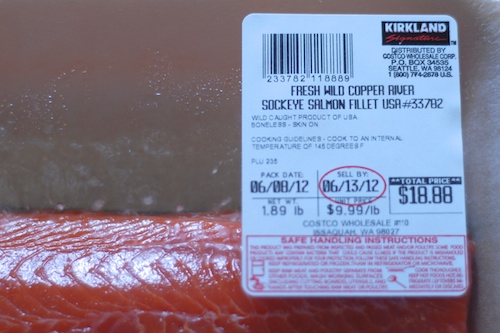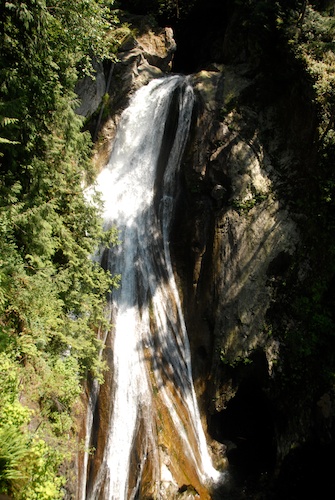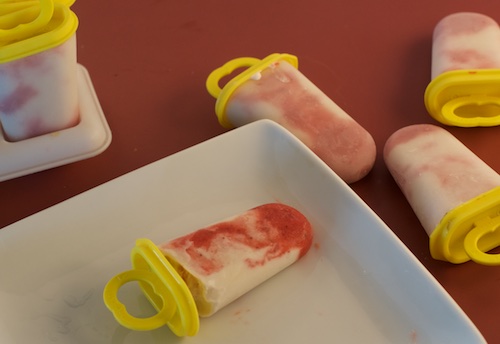Fresh Copper River salmon is one of the pleasures of Northwest spring and summer. When we have a guest over for dinner, or maybe just a sunny day, we buy salmon and a few other items for the grill and fire it up. Check out what I pay for never-frozen Copper River sockeye, but don’t hate me for it:

Costco Copper River sockeye salmon
Excellent salmon like this is good grilled plain with olive oil and salt, but a marinade can be excellent too. I often use a recipe from my friend Christina, marinading the fish in ginger, garlic, tamari and rum (though lately, I more often use bourbon).
This time I didn’t cut the fish into individual portions before marinating, though my husband prefers that on the grounds that it helps get every part of the fish evenly exposed to the marinade. You may hear from your fishmonger that leaving the fish whole will help it stay juicy. That may be true, but it’s so much easier for my husband to handle it on the grill when it’s been cut up. And dryness is not an issue on our enclosed Big Green Egg grill that keeps food nice and moist. Cutting the fish can also help when the thickness of the fillet varies and the thinner pieces will need a slightly shorter cooking time.

marinating the salmon in a gallon Zip-lock bag
Ready to grill. My husband has cut the salmon into portions to make the fish easier to flip on the grill.

salmon marinated and cut into individual filet portions
Knowing when the salmon is done is tricky and honestly, we don’t always get it right. Being mostly vegetarian, we had a tendency to think of food safety and err on the side of getting the salmon cooked all the way through, which results in a fish that is too dry. Trying to avoid that, we began overcorrecting and getting sashimi inside. We used to grill at 450, but are getting more consistent results now at 350.
You should be able to flake the salmon apart even in the middle when it’s done enough, and the salmon will be beginning to become opaque. But it won’t be completely opaque yet in the middle, there should still be a little transparency. It cooks a little more in the first couple of minutes after you take it off the grill, and you have to account for that. Seattle Local Food has a detailed post on how to cook salmon perfectly: other than that, my best tip is to watch it carefully and don’t be afraid to pick it apart to check the middle. You can always eat the piece with the hole in it yourself, it’s better than overcooking the whole salmon.
Summer 2013 update: While this ‘just flaked’ guideline is correct, we now have enough experience with our Big Green Egg grill to have luck simply timing the fish. With the grill at 350 degrees and a 3/4″ inch thick salmon, 3 minutes per side is just right.
Here’s the Copper River sockeye on the table with grilled asparagus, grilled pineapple, and black (forbidden) rice:

Salmon dinner with grilled asparagus, grilled pineapple, and black rice
Dessert was a strawberry rhubarb crumble. Here’s the salmon recipe:
- ¼ cup gluten-free tamari
- ¼ cup water
- ¼ cup rum or bourbon
- 1 Tbsp. peeled and minced ginger
- 6 cloves garlic, peeled and minced
- 1 Tbsp. unrefined brown sugar
- 1½ to 2# wild Pacific salmon fillet, cut into 4-6 oz portions
- 1 Tbsp. toasted sesame or extra virgin olive oil.
- Cut salmon into individual portions before marinating to increase exposure of the fish to the marinade. It's also helpful for grilling because it's easier to move the fish around on the grill when it's already cut.
- Add first six ingredients, then the salmon, to a gallon ziplock bag, seal.
- Refrigerate for several hours to 1 day, turning several times if possible. The longer the better.
- Preheat grill to 350 F.
- Lightly coat the fillet in the oil, then place on the grill flesh side down.
- Cooking time will vary based on the thickness of the fish-- cooking time for salmon tends to be less than the 10 minutes per inch that you usually hear for fish. On a 350 degree grill we are finding 3 minutes per side to be just right for fish that is about ¾ inch thick.







{ 0 comments… add one now }